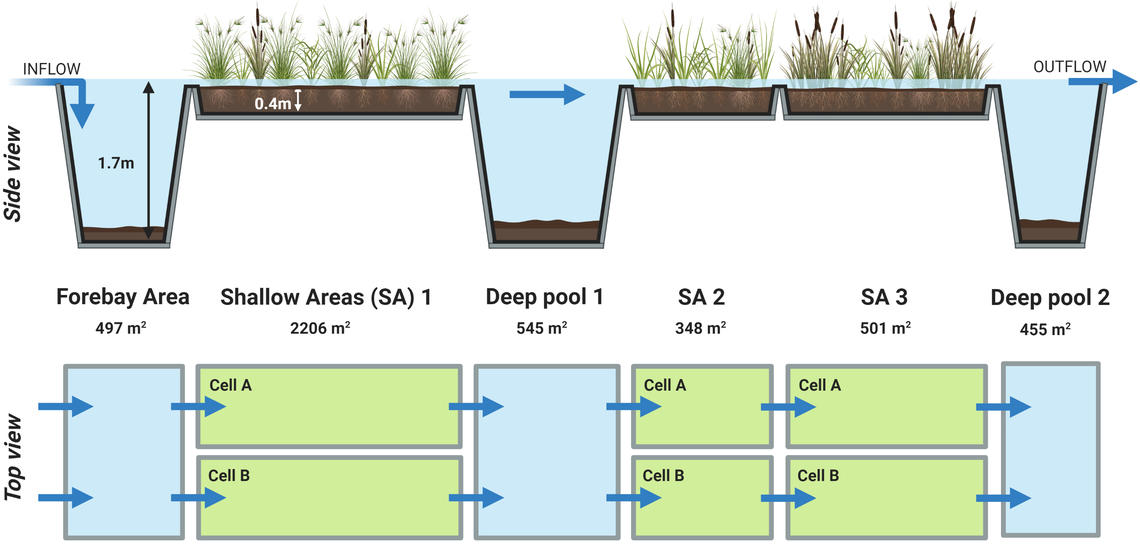Nov. 3, 2021
Genomics project awarded $6M in funding for research into oilsands remediation

Alberta’s oilsands mining industry is an integral part of Canada’s economic landscape. To help balance bitumen production and environmental targets, oil sands operators are investigating new technologies to responsibly manage their environmental impact.
Dr. Doug Muench, PhD, a professor in the Department of Biological Sciences, is a plant biologist who is co-leading a multi-institutional grant valued at over $6.3 million from Genome Canada to enhance constructed wetland treatment systems for the bioremediation of oilsands process-affected water (OSPW).
Microbes and plants can work together to remediate OSPW
Muench and the research team (co-led by microbiologist Dr. Christine Martineau, Natural Resources Canada) will use genomics approaches to investigate how wetland plants and microbes can work together to help remove contaminants from the wastewater that results from bitumen extraction. While there is some understanding of the microbial genes and biochemical pathways involved, Muench says that the team will learn more about the molecular aspects of remediation and the role of plants in these processes. The research will provide insight into commercialization of this OSPW remediation approach.
Constructed wetland treatment systems — specially designed wetlands that can remove contaminants from industrial wastewater — are scalable and cost effective, and could play a major role in addressing the challenge of remediating OSPW. The conditions needed to create optimal constructed wetlands to detoxify OSPW, however, are not yet well understood.
“OSPW contains a broad class of organics — called naphthenic acids — that consist of more than a thousand different compounds and appear to be a main contributor to aquatic organism toxicity,” Muench explains. “So it's not just one thing that we're targeting. We know that microbes can degrade many naphthenic acid types, but we also know that they have a tough time with some that have a more complex structure. We demonstrated that plants can effectively remediate some of these compounds, so it seems to be a co-operative remediation process.”

Muench lab phytoremediation team: Aidan McKenna, Mitchell Alberts, Doug Muench, Camryn Charriere and Ralph Hindle.
Doug Muench
"We want to enhance the efficacy of constructed wetland treatment systems to treat the large volumes of OSPW that are stored on site.”
The UCalgary research team also includes co-investigator Dr. Lisa Gieg and collaborators Drs. Gordon Chua, Marcus Samuel, and Ray Turner. Several other research labs from across Canada are also key participants in this project.
Pilot constructed treatment wetland system
In addition to lab and greenhouse-scale experiments, the research team will have the opportunity to study the genomic aspects of a pilot-scale constructed treatment wetland that is located on an oilsands lease operated by Imperial. This one-hectare wetland will be valuable in measuring microbial and plant species dynamics as well as the environmental effects on OSPW remediation effectiveness.
Muench explains “The microbes and wetland plants used in this research are sourced from the oilsands region. Using genomics tools, we will identify microbial communities and conditions that demonstrate enhanced OSPW remediation. Although the project is heavy on genomics, there are definitely some design components to this project as well, including determining the best soil substrate conditions for growing plants and microbes.”
The plant component of this project will be a focus for Muench’s lab and is an extension of over a decade of research that included studies on the cellular effects of naphthenic acid toxicity. This research is related to another project in his lab that is funded through an NSERC Innovation Links grant in collaboration with Northern Alberta Institute of Technology researchers, and is focused on phytoremediation of OSPW using upland plants, such as willow.

Schematic diagram of the pilot constructed wetland treatment system.
Imperial Oil
The project is one of eight large-scale research projects that received a total of $60 million in funding from the Genome Canada LSARP program and Natural Resources Canada, with provincial and other federal partners, universities, industry and international partners. Together, these eight projects will advance Canada’s biodiversity and responsible stewardship of resources, harness biomonitoring to measure changes in living organisms to assess potential hazardous exposure and apply bioremediation to identify and remove pollutants from water, soil and other environments.






